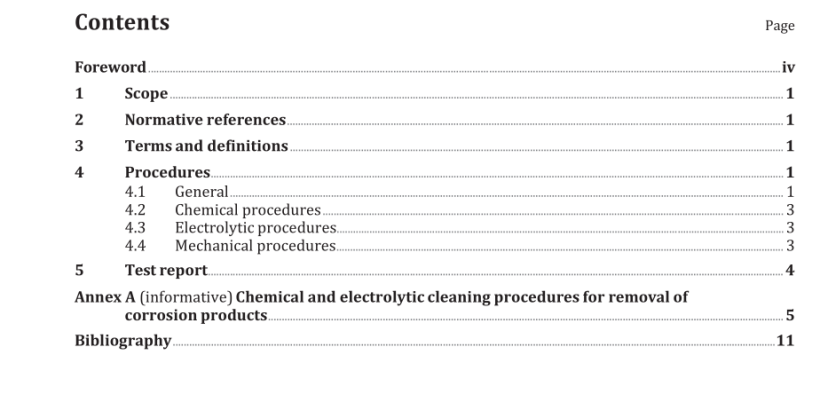ISO 8407:2021 pdf download – Corrosion of metals and alloys — Removal of corrosion products from corrosion test specimens.
1 Scope This document specifies procedures for the removal of corrosion products formed on metal and alloy corrosion test specimens during their exposure in corrosive environments. For the purpose of this document, the term “metals ” refers to pure metals and alloys. The specified procedures are designed to remove all corrosion products without significant removal of base metal. This allows an accurate determination of the mass loss of the metal, which occurred during exposure to the corrosive environment. In some cases, these procedures are also applicable to metal coatings, providing the possible effects from the substrate are considered. 2 Normative references There are no normative references in this document. 3 Terms and definitions No terms and definitions are listed in this document. ISO and IEC maintain terminological databases for use in standardization at the following addresses: — ISO Online browsing platform: available at https://www.iso .org/obp — IEC Electropedia: available at http://www.electropedia .org/
4.1.3 An ideal procedure should remove corrosion products and not result in the removal of any base metal. Two procedures can be used to confirm this point. One procedure uses a control specimen (see 4.1.4) and the other requires a certain number of cleaning cycles on the corroded specimen (see 4.1.5). The procedures shall be maintained while the rust removal performance of the solutions listed in Tables A.1 and A.2 is not impaired. NOTE 1 Indications that the solution needs to be discarded can be discoloration or the presence of a significant amount of corrosion products in the solution. NOTE 2 Some solutions might need some aging before working without etching the substrate. 4.1.4 Uncorroded control specimens, which should be similar chemically, metallurgically and geometrically to the test specimens, should be cleaned by the same procedure as used for the test specimen. By weighing the control specimen before and after cleaning (weighing to the fifth significant figure is suggested, e.g. a 70 g specimen should be weighed to three decimal places), the metal loss resulting from cleaning may be determined. The mass loss of the control specimen will reflect the mass loss of test specimens resulting from the cleaning procedure.
4.1.5 The cleaning of each corroded test specimen should be repeated several times after the removal of the corrosion products is completed. The mass shall be plotted as a function of the periods of cleaning cycles with the same interval time or time units (see Figure 1 ). Point A represents the mass of corroded specimens before the start of the cleaning. In many cases, two straight lines, AB and BC, will be obtained. Line AB characterizes the removal of corrosion products and may not always be visible. Line BC characterizes the removal of the substrate after the corrosion products are completely removed. Point D, which characterizes the mass of the pure metal at zero number of cleaning cycles, is obtained by extrapolation of line BC to the ordinate axis. In some cases, the relationship may not be linear, and the most appropriate extrapolation shall then be made. If the relationship of B and C is not linear, a linear regression method, e.g. by applying the least squares from later points of cleaning cycles, can be used for estimation of the point for the D value. If the durations of each cleaning step are not equal, the x-axis should be expressed in units of cumulative exposure time in the cleaning solution, rather than the number of cleaning steps used up to that point.
4.1.8 When chemical or electrolytic procedures are used, solutions freshly prepared with distilled or deionized water and reagent grade chemicals shall be used. 4.1.9 After cleaning, the specimen should be thoroughly rinsed with tap water. A light brushing during this procedure will help to remove any remaining surface products resulting from the cleaning process. Finally, the specimens shall be rinsed with distilled or deionized water. The specimen shall then be rinsed thoroughly in ethanol and dried in air. Drying in an air stream is strongly recommended, or optionally a hot air blower or an oven may be used. After drying, the specimens shall be allowed to cool in a dessicator to the balance room temperature before weighing. 4.2 Chemical procedures 4.2.1 Chemical procedures involve the immersion of the corroded test specimen in a chemical solution that is specifically designed to remove the corrosion products with minimal dissolution of any base metal. Several procedures are listed in Annex A (see Table A.1). To facilitate the cleaning, an ultrasonic bath treatment should be used.
